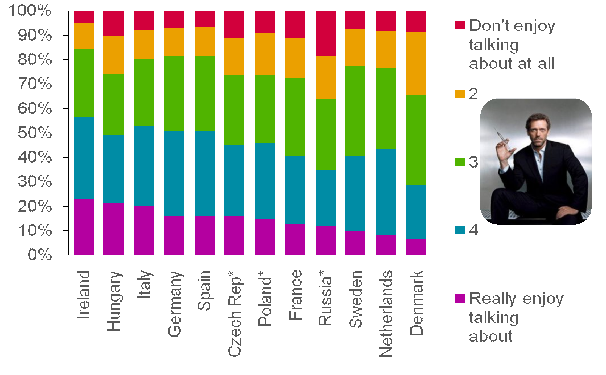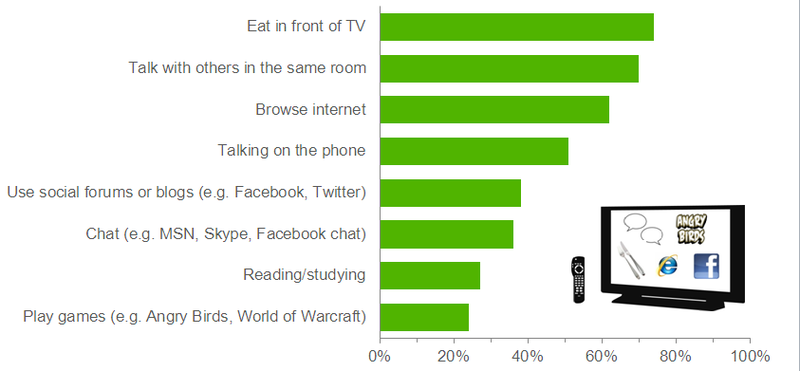How to stop hating ads and turn them into useful content

The ideal of modern advertising: it works in such a way that friends advise you
Chantal Rickards is the head of one of the divisions of the large media agency MEC, which buys about a third of advertising on the planet .
Chantal is the person who knows all the communications of Microsoft, Sony, Honda, Bacardi, Barclays, IKEA and other “fashion-defining” brands and at the same time creates the future of the media environment. Prior to that, she worked on the BBC and other channels, engaged in advertising, worked in show business. In general, now this woman is sure that she knows what the media environment will turn into in a few years - and knows what needs to be done in order to get maximum profit from it.
')
Chantal begins by saying that one of the ideals of the modern network is maximum segmentation. You can catch a particular person "by the hand", and give him the advertising that will have the greatest effect. By the way, this is why Google seriously fears Facebook - only the feature of segmentation by interests and groups is worth huge advertising budgets.
Three ways to bring advertising
- Direct: pay it on the media channel, for example, run on TV or start a contextual campaign.
- The second option is to place it on your resource, for example, in a Facebook group or on a website.
- And a new category: “attracted media” is a concept already from a new era. These are the means of obtaining information that you trust in the same way as if a friend told you about a product. The most striking example of the work of this category is the repost of the post by someone from friends in the social network.
MEC sits in the middle between the company and these three channels and serves as a kind of brain activity center. Chantal builds a communication strategy, translates messages into the language of the audience, provides logistics (agreements with site owners) and changes the media environment itself (more precisely, carrier sites), telling what it needs. Considering that MEC is a third of global advertising, it is carefully listened to.
Is the TV still alive?
Despite the fantastic networking opportunities, the most effective channel for large businesses is still television. And it is there that the main budgets are concentrated. However, as Christopher Sanberg has already said , the TV without interactive will soon cease to convulse and will go to another world. Chantal tries to add this interactive and makes advertising, in fact, part of the content, and not something separate.
This is exactly the thing that is important for advertising on TV today - a two-way dialogue.

Russia doesn’t like to discuss TV
What if you cut the ad?
There is a DISH company that is going to release a recording device that will automatically remove ads. Many believe that advertisers will not survive this. Modern television channels finance their programs through advertising. If the audience does not watch their ads, then there is a gap in the commercial model of television. For the time being, there is an active debate on whether television will deteriorate from this: after all, more advertising financing means greater budgets for normal content.
But what do consumers want? They want great content. What do brands want? They want to deliver this great content, because if they can get their message directly into the program when the audience doesn't rewind, then this message will be powerful. From here - sponsorship and integration into programs.
How to get inside the content?
When an advertiser pays for his content, he can create his own DNA and bring it inside the program. The point is not to turn the transfer into a solid advertisement, but also to convey what is needed to a potential client. We are talking about product placement and other similar measures. At the same time, the peculiarity of Europe and Russia is the fact that the more pronounced such placement is, the more disgust for advertising is caused by the viewer: it’s in the US that many people are used to, they just get hit in the face with advertising, our model is not optimal.
How is television and network connected?
Simple enough. If you have a television program, you can make podcasts, books, and other materials from it. For example, a show script is a book. Recipes from the program about the cook - this application for the tablet. Chantal believes that it is important not to repeat the advertisement N times, but to convey it on various channels in order to create trust. And smart to embed in content, because it is he who creates this trust.
Another important aspect is that people look at two screens at once. Here is the schedule for using TV in Russia:

What do people do in front of the TV
As you can see, most often people eat in front of the TV, and they talk a lot of time with other people when they watch TV. In third place is web surfing. Then they talk on the phone. Many people in Europe still use social networks while watching, most often Twitter and Facebook. Content creators have already begun to understand the importance of this aspect: when someone watches their channel, he shares his impressions with other people.
A simple way to use this knowledge is a classic campaign with engaging user-generated content. This may be a competition of videos that are shown on television, for example. The next step was a campaign for a single drug, where stars taught people to dance. In parallel, flashmobs were held in shopping centers: reality was closely intertwined with content.
The third step was the invention of the changing roller . The Chantal team shot an advertisement about a nightclub: the result was a video on YouTube that changed depending on the number of views. The more people - the sexier the video: the club became hotter and hotter. People called friends through social networks, mail and other channels - all in order to see what will change in the club further. As a result, the audience is eleven and a half million people.
Summary
When the effectiveness of communications decreases, you can increase the intensity of advertising. It will work for a while, but an increasing number of people will look at you negatively. The second option is to enter into a two-way dialogue and listen to what exactly your audience needs, and then do it. By and large, we can say that the audience to some extent orders entertainment content, and brands provide it with their DNA.
References:
- Lecture Chantal Rickards at Digital October in Russian and English;
- MEC Works Examples
Source: https://habr.com/ru/post/145130/
All Articles